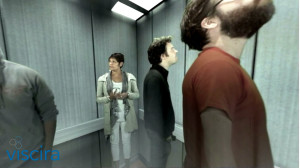 Mood and thought disorders, like depression and dementia, are very common ailments that have a huge impact on our society. Countries spend vast amounts of money every year to try and treat them. Because they are so common, it is very valuable for anyone to better understand these disorders and get to empathize with people suffering from them.
Mood and thought disorders, like depression and dementia, are very common ailments that have a huge impact on our society. Countries spend vast amounts of money every year to try and treat them. Because they are so common, it is very valuable for anyone to better understand these disorders and get to empathize with people suffering from them.
What if you could literally put yourself inside the mind of someone who suffers from a mood or thought disorder? This is the promise of Virtual Reality that we are going to explore here.
Below are some scenarios that could be tested in Virtual Reality:
As mood and thought disorders are obviously a vast subject, I’m not going to expand too much on it right here. In-depth coverage of the topic would require one or several books, many experiments and expert analysis in neuroscience and psychology to do so.
However, I want to touch on the topic of empathy and how Virtual Reality can help understanding and empathize with people suffering from mood and thought disorders.
Specific scenarios can be put together so that participants can better understand what it feels like to be suffering from depression or anxiety, for example.
 For depression, the visual perception of the world could be altered (sounds could be slightly muted), movement could be slowed down, the world could take a darker tint. These artifacts would help creating a depressed mood for a start. Finally, the participant could be asked to perform hard tasks with no real reward at the end to get a better feeling for a depressive state. In fact, a video game exploring the topic of depression has already been made: Depression Quest.
For depression, the visual perception of the world could be altered (sounds could be slightly muted), movement could be slowed down, the world could take a darker tint. These artifacts would help creating a depressed mood for a start. Finally, the participant could be asked to perform hard tasks with no real reward at the end to get a better feeling for a depressive state. In fact, a video game exploring the topic of depression has already been made: Depression Quest.
For anxiety, stressful and threatening situations can be put together. For example, the “actor” can be put in a life and death situation, where he has to make quick decisions, while under pressure from other people around him.
For dementia, the world could be manipulated to make it difficult for the participant to remember events. For example, by making different places look similar so that it is hard to remember whether a particular place has already been visited or not.
For Parkinson, shaking movements can be added so that it is hard to grab and manipulate objects.
And for Schizophrenia, voices could be added to the world that make it  look like they have been spoken by someone even though they haven’t. Also, hallucinations and visual distortions can be added to the world. Such experiments have already been done, you can find an example here: “Virtual Hallucinations”, a virtual reality simulation
look like they have been spoken by someone even though they haven’t. Also, hallucinations and visual distortions can be added to the world. Such experiments have already been done, you can find an example here: “Virtual Hallucinations”, a virtual reality simulation
All these scenarios could take place in an offline or online world. In the latter, reactions from others that might not be conscious of how the participant perceives the world would actually really help with empathizing with people suffering from mood and thought disorders. This as the participant would really understand what it feels like to be perceived as “different” by others.
To summarize, many highly beneficial scenarios can be put together to really increase the empathy of anyone towards people suffering from mood and thought disorders. As this is not the focus here, I have not touched on using Virtual Reality to treat these disorders, but this is also an important field, where VR can be hugely beneficial. For example, very effective treatments have been put together to cure anxiety disorders through Virtual Reality.
We have now covered many areas of Extreme Empathy through the last 8 posts. This exploration on empathy in Virtual Reality doesn’t stop there as other areas can definitely be explored. I will however leave the subject here to move on to other topics.
Nevertheless, to part in good terms, I will write a small conclusion on this exploration in a dedicated post, coming next.







Please share your comments